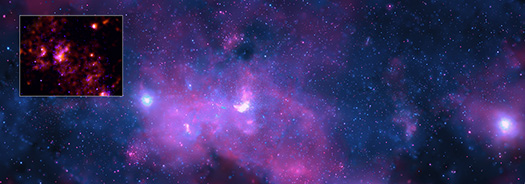Studies of Past X-ray Flares from Sgr A*
Submitted by chandra on Wed, 2023-06-21 13:35In a new Nature paper astronomers have reported exciting evidence that the supermassive black hole at the center of our Galaxy, Sagittarius A* (Sgr A* for short), produced an intense flare of X-rays about 200 years ago. Sgr A* is 28,000 light-years from Earth, but even from this considerable distance, if a similar flare occurred today then X-ray telescopes like IXPE and Chandra may be damaged if they looked at Sgr A*.
Currently Sgr A* shows frequent but weak outbursts, and has been referred to as a “sleeping giant” by members of the Event Horizon Telescope Collaboration.
In the new study astronomers learned about Sgr A*’s past outbursts by observing X-rays from clouds of gas around the supermassive black hole. While the primary X-rays from previous outbursts would have reached Earth in the past, X-rays reflected from clouds of gas will take a longer path and can arrive in time to be recorded by telescopes like Chandra and IXPE. This idea goes back decades, with the astronomers referring to a paper published in 1980. In the 1990s, several papers reported evidence for X-ray flares from the center of the Galaxy, including one in 1996 titled “ASCA View of Our Galactic Center: Remains of Past Activities in X-Rays?”.
Milky Way's Central Black Hole Woke Up 200 Years Ago, NASA's IXPE Finds
Submitted by chandra on Fri, 2023-06-16 17:24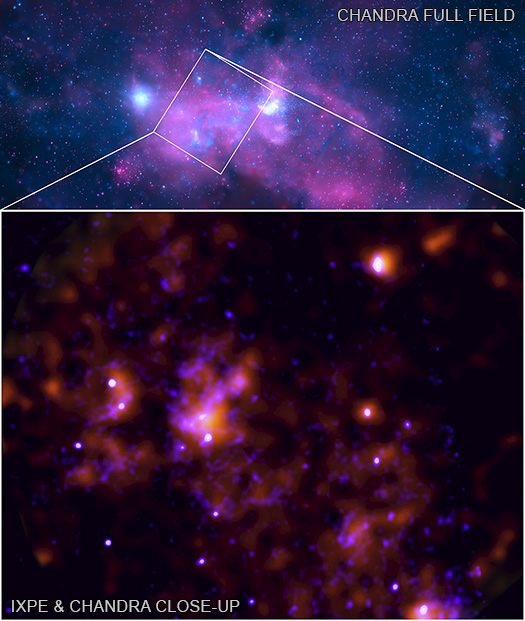
Sagittarius A* / Galactic Center
Credit: Chandra: NASA/CXC/SAO; IXPE: NASA/MSFC/F. Marin et al; Image Processing: L.Frattare, J.Major & K.Arcand; Sonification: NASA/CXC/SAO/K.Arcand, SYSTEM Sounds (M. Russo, A. Santaguida)
These images show X-ray data of the area around the supermassive black hole at the center of the Milky Way galaxy. New data from NASA’s Imaging X-ray Polarimetry Explorer (IXPE) has provided evidence that this black hole — known as Sagittarius A* (Sgr A*) — had an outburst about 200 years ago after devouring gas and dust within its reach.
A Pair of Merging Galaxies Ignite Black Holes on a Collision Course
Submitted by chandra on Wed, 2023-04-05 10:58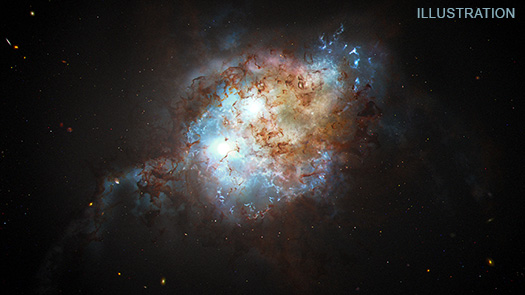
Artist's Illustration of Dual Quasar J0749+2255
Artwork Credit: NASA, ESA, Joseph Olmsted (STScI) Science Credit: NASA, ESA, Yu-Ching Chen (UIUC), Hsiang-Chih Hwang (IAS), Nadia Zakamska (JHU), Yue Shen (UIUC)
Quasars are among the universe's brightest fireworks. Scattered all across the sky, they blaze with the opulence of over 100 billion stars. And, like a brilliant July 4th aerial flare, they are dazzling for a relatively brief time — on cosmic timescales. That's because they're powered by voracious supermassive black holes gobbling up a lot of gas and dust that gets heated to high temperatures. But the quasar food buffet lasts only so long.
This fleeting characteristic of quasars helped astronomers find two quasars on a collision course with each other. They are embedded inside a pair of galaxies that smashed into each other 10 billion years ago. It's rare to find such a dynamic duo in the far universe. The detection yields clues as to how unsettled the cosmos was long ago, when galaxies more frequently collided and black holes were engorged with flotsam and jetsam from the close encounters.
Chandra's Indirect Glance into the Early Universe: Merging Dwarf Galaxies and their AGN
Submitted by chandra on Fri, 2023-02-17 14:49We are pleased to welcome Marko Mićić as a guest blogger. Marko led the study that is the subject of our latest press release [link to PR]. He graduated from the University of Belgrade, Serbia, with a degree in Astronomy and Astrophysics, in 2018. The same year he started a Ph.D. at the University of Alabama, and has been working under Dr. Jimmy Irwin's supervision since then. His research interests include evolution of low-mass galaxies, AGN content of low-mass galaxies, intermediate-mass black holes and gravitational lenses.
Galaxies are made up of billions of stars, interstellar gas and dust, and large amounts of dark matter. Every (or almost every) galaxy is expected to host a supermassive black hole in its center. Galaxies and their central black holes grow and evolve together predominantly through mergers; smaller objects merge to create larger ones over time. However, the earliest stages of galaxy evolution involving the mergers of the first galaxies are poorly understood. It is unclear how the first mergers affected the morphology of ancient galaxies and their star formation. We also do not know how massive the first black holes were that inhabited the first galaxies, nor how the first mergers influenced their ability to accrete – pull in – material.
It is challenging to answer these important questions because the first mergers are too distant and faint to be directly observed. One way to overcome this issue is to look for local analogs. In other words, we need to find pairs of small, dwarf galaxies that have had very quiet lives, with almost no mergers, that have only recently met and started interacting. Such galaxies have experienced little to no evolution so they are analogs of distant, ancient galaxies, and observations of their mergers would represent the local case study that illustrates the hierarchical growth of structures in the early Universe. Their central black holes are also expected not to have grown much and preserve information about primordial seeds, potentially holding the key to resolving the outstanding problem of the origin of supermassive black holes.
Astronomers Dig Out Buried Black Holes With NASA's Chandra
Submitted by chandra on Wed, 2023-01-11 14:20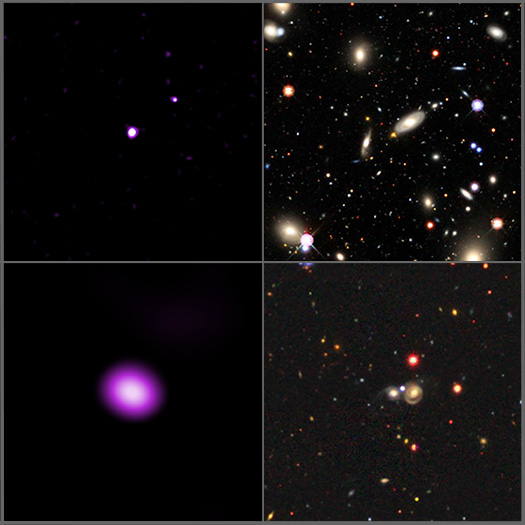
SDSS J011522.18+001518.5 and SDSS J155627.74+241758.9
Credit: X-ray: NASA/CXC/SAO/D. Kim et al.; Optical/IR: Legacy Surveys/D. Lang (Perimeter Institute)
This panel of images represents a survey that used data from NASA’s Chandra X-ray Observatory to uncover hundreds of previously “hidden” black holes. This result helps astronomers conduct a more accurate census of supermassive black holes that exist in the centers of most large galaxies, as reported in our latest press release.
This graphic shows two of the galaxies from the new study, with Chandra X-ray data in purple and optical data from the Sloan Digital Sky Survey (SDSS) in red, green and blue. These black holes were found in galaxies that are dim in optical light, but bright in X-rays. Astronomers have dubbed these “XBONGs” (for X-ray bright, optically normal galaxies). While scientists have been aware of XBONGs for several decades, an explanation for their unusual properties has been unclear.
'Listen' to the Light Echoes From a Black Hole
Submitted by chandra on Mon, 2022-11-21 10:31Credit: X-ray: Chandra: NASA/CXC/U.Wisc-Madison/S. Heinz et al.; Swift: NASA/Swift/Univ. of Leicester/A. Beardmore; Optical/IR: PanSTARRS; Sonification: NASA/CXC/SAO/K.Arcand, SYSTEM Sounds (M. Russo, A. Santaguida)
One of the surprising features of black holes is that although light (such as radio, visible, and X-rays) cannot escape from them, surrounding material can produce intense bursts of electromagnetic radiation. As they travel outward, these blasts of light can bounce off clouds of gas and dust in space, similar to how light beams from a car’s headlight will scatter off fog.
A new sonification turns these “light echoes” from the black hole called V404 Cygni into sound. Located about 7,800 light-years from Earth, V404 Cygni is a system that contains a black hole, with a mass between five and 10 times the Sun’s, that is pulling material from a companion star in orbit around it. The material is funneled into a disk that encircles the stellar-mass black hole.
NASA Telescopes Capture Stellar Delivery Service for Black Hole
Submitted by chandra on Thu, 2022-08-18 11:54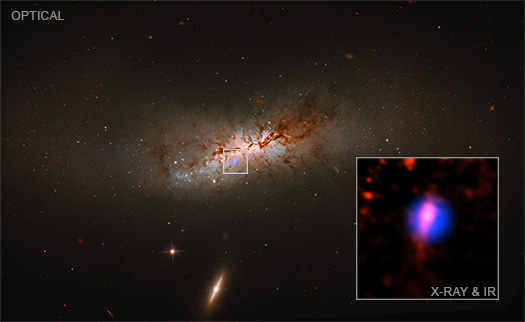
NGC 4424
Credit: X-ray: NASA/CXC/Swinburne Univ. of Technology/A. Graham et al.; Optical: NASA/ESA/STScI
Astronomers may have witnessed a galaxy’s black hole delivery system in action. A new study using data from NASA’s Chandra X-ray Observatory and Hubble Space Telescope outlines how a large black hole may have been delivered to the spiral galaxy NGC 4424 by another, smaller galaxy.
NGC 4424 is located about 54 million light-years from Earth in the Virgo galaxy cluster. The main panel of this image, which has been previously released, shows a wide-field view of this galaxy in optical light from Hubble. The image is about 45,000 light-years wide. The center of this galaxy is expected to host a large black hole estimated to contain a mass between about 60,000 and 100,000 Suns. There are also likely to be millions of stellar-mass black holes, which contain between about 5 and 30 solar masses, spread throughout the galaxy.
Chandra Unveils Rotation Speed of One of the Most Massive Black Holes Ever Seen
Submitted by chandra on Thu, 2022-06-30 11:49
Julia Sisk-Reynés
Our guest contributor is Julia Sisk-Reynés, the leader of a new black hole study that is the subject of our latest press release. Julia is a second-year PhD student at the Institute of Astronomy at the University of Cambridge, UK, where she is a member of the X-ray group working mainly with Prof. Chris Reynolds and Dr. James Matthews. Her primary focus is on constraining beyond the Standard Model Physics – in particular, axion-like particles (ALPs)- with X-ray observations of cluster-hosted active galaxies. The team have recently set the tightest limits to-date on the coupling of very light ALPs to electromagnetism with Chandra X-ray observations of the cluster-hosted quasar H1821+643. Julia came to Cambridge in 2020, straight after graduating from the University of Manchester with a master’s degree in physics. Amongst others, she did a project on assessing the sensitivity of the DarkSide-20k liquid argon experiment in Gran Sasso, Italy, to direct dark matter detection.
Black holes are one of the most tantalizing objects in the Universe. By 1915, Einstein’s Theory of General Relativity had introduced the notion that the gravity of black holes is so strong that they can distort the space-time around them … to the point where even light close to the black hole cannot escape! More recently, astronomers have gathered evidence that most – if not all – galaxies emitting lots of light at the center (also called active galactic nuclei or AGN) host a very massive black hole at their core. It is known that the properties of AGN and their central black holes are often linked. For example, the heavier the AGN, the heavier its host black hole. Therefore, the formation, growth, and evolution of black holes over time and their connection with the properties of their host galaxies are fascinating topics for astronomers to pursue.
Astronomers classify black holes into three groups, depending on their mass. Firstly, stellar-mass black holes, thought to form from the gravitational collapse of a star, weigh a few to a few tens of times the mass of the Sun. Then, we have a class of black holes of unknown origin which range from hundreds to tens of thousands of Suns, often referred to as “intermediate mass” black holes. A gravitational wave event detected in 2019 by the LIGO and VIRGO collaborations confirmed the existence of a black hole in this second category. Finally, supermassive Black Holes (SMBHs) weigh between millions and billions of Suns. While their origin is still debated, what we do know is that accretion, that is, the feeding of gas onto such black holes, is responsible for the X-ray emission coming from the AGN that surround them.
Looking at the Team Behind the Science
Submitted by chandra on Thu, 2022-05-12 11:41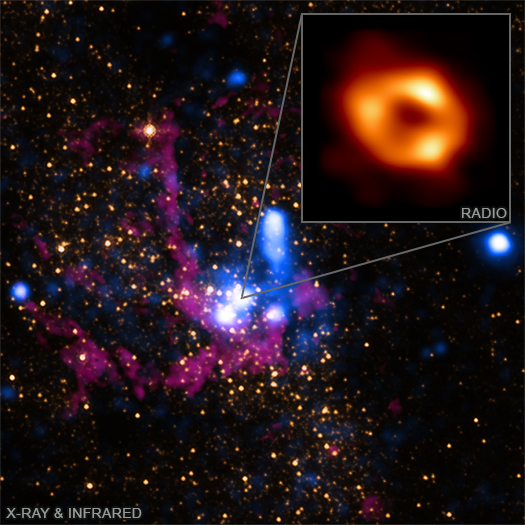
Sagittarius A*: The Black Hole at the Center of the Milky Way Galaxy
Credit: X-ray: NASA/CXC/SAO; IR: NASA/HST/STScI. Inset: Radio (EHT Collaboration)
Many projects in astrophysics involve huge numbers of scientists and other collaborators — often ranging from senior professors to graduate students and undergraduates. A project like the EHT often requires smaller groups within these large collaborations to concentrate on different problems and questions.
The latest result about the Milky Way's central black using many different telescopes in concert with the Event Horizon Telescope (EHT) is an excellent example of such a successful web of groups working together with others in the project to make the sum even greater than its parts.
To learn more about the group behind the "multiwavelength" (MWL) observations that included Chandra and other telescopes, we asked Sera Markoff and Daryl Haggard, two of the coordinators of the EHT's MWL Working Group, a series of questions.
New NASA Black Hole Sonifications with a Remix
Submitted by chandra on Wed, 2022-05-04 11:38Credit: X-ray: NASA/CXC/Univ. of Cambridge/C. Reynolds et al.; Sonification: NASA/CXC/SAO/K.Arcand, SYSTEM Sounds (M. Russo, A. Santaguida)
Black Hole at the Center of the Perseus Galaxy Cluster (above)
Since 2003, the black hole at the center of the Perseus galaxy cluster has been associated with sound. This is because astronomers discovered that pressure waves sent out by the black hole caused ripples in the cluster's hot gas that could be translated into a note — one that humans cannot hear some 57 octaves below middle C. Now a new sonification brings more notes to this black hole sound machine. This new sonification — that is, the translation of astronomical data into sound — is being released for NASA's Black Hole Week this year.
In some ways, this sonification is unlike any other done before (1, 2, 3, 4) because it revisits the actual sound waves discovered in data from NASA's Chandra X-ray Observatory. The popular misconception that there is no sound in space originates with the fact that most of space is essentially a vacuum, providing no medium for sound waves to propagate through. A galaxy cluster, on the other hand, has copious amounts of gas that envelop the hundreds or even thousands of galaxies within it, providing a medium for the sound waves to travel.
Pages
Please note this is a moderated blog. No pornography, spam, profanity or discriminatory remarks are allowed. No personal attacks are allowed. Users should stay on topic to keep it relevant for the readers.
Read the privacy statement

